When asked most people would describe their coffee fairly simply: hot, black, sweet, creamy or expensive. Coffee has the most magical smell drawing you into a cup of creamy bitterness that gives you that morning shot of energy you needed to get out the door. And if you drink one cup, perhaps you drink 2-4 more cups throughout the day. There are plenty of health benefits to drinking coffee, but also plenty of controversies. So what about the quality of your coffee? Are there ingredients that may be inside that cup that you don’t find on the label? Yes, so let’s go through all that. You’ve trusted Mamavation to bring you topics like teas with the safest sachets in hot water, safest cookware, and how to avoid newly returned “pink slime,” now join us as we bring you all the best coffee brands.
Disclosure: This post contains affiliate links to Amazon and was fact-checked by Rebecca Elizabeth Sherrick Harks, Registered Nurse.

Table of Contents
Coffee Has Incredible Health Benefits
Coffee is hands down good for you in incredible ways. Here are some of the health benefits.
- It protects your brain. High caffeine levels in your blood reduce the risk of Alzheimer disease, which is something you want to avoid. It also lowers risk of dementia, so keep feeding it to grandma.
- It brightens your mood. Caffeine stimulates the central nervous system, which boosts production of neurotransmitters like dopamine, serotonin, and noradrenaline. This elevates your mood. As much as two cups a day of coffee prevents the risk of suicide by 50 %.
- It may lower the risk of type 2 diabetes. Caffeine decreases your insulin sensitivity and impairs glucose tolerance, therefore it has the ability to reduce your risk of type 2 diabetes.
- It protects your body with antioxidants. Coffee contains a lot of antioxidants. This may be your largest amount of the day if you don’t eat lots of berries already. Other countries have found that coffee is their largest source of antioxidants in a day. Antioxidants work as little warriors fighting and protecting against free radicals within your body.
- It can reduce your risk of stroke. When you drink between 2-4 cups of coffee per day, it’s associated with a lower risk of stroke.
- It can reduce your risk of Parkinson’s. Studies have shown that coffee drinking decreases the risk of Parkinson’s disease by 25 % in most people. There’s evidence that coffee causes activity in the part of the brain affected by Parkinson’s and that activity protects them from demise.
- It can reduce your risk of certain cancers. One study demonstrated that coffee may decrease the risk of developing prostate cancer in men by 20 %, and endometrial cancer in women by 25 %. Caffeine may also prevent developing basal cell carcinoma, the most common type of skin cancer, which is very prevalent in the United States.
- It can lower your risk of death. Studies have shown that when you drink coffee your overall risk of premature death drops about 25% compared with the rest of the population. So coffee affords some type of health protection.
- It can help you stay focused and alert. Drinking between 1-6 cups per day helps you focus and improves your mental alertness.
- It can help you lose weight. Coffee contains some of the nutrients your body needs to lose weight–magnesium and potassium. This helps your body use insulin, regulating blood sugar levels and reducing your craving for sugary treats and snacks. That caffeine in your coffee then helps fat cells break down body fat and use it as fuel for training in your workout.
- It can increase your physical performance. If you had a cup of black coffee about an hour before a workout, you would notice your performance improving by 11-12%. That’s because caffeine increases adrenaline levels in your blood. Adrenaline is your body’s “fight or flight” hormone which helps you to prepare for physical exertion.
Coffee is the Second Largest Crop in the World
Coffee is one of the largest crops in the world, worth around $16.5 billion in the United States alone. Next to the European Union and Brazil, the United States is one of the largest importers of coffee. The International Coffee Organization estimates 26 million are employed across 52 countries in the coffee business. Most of these companies are agribusiness conglomerates seeking aggressive ways to maximize profits. This means toxic chemicals are used to ward off pests and disease, shoddy storage and processing methods can introduce mycotoxins, and workers and the environment could be in peril. Mamavation will attempt to help you make sense of your coffee purchase and its impacts on your health and our world.
It’s safe to say there is higher quality coffee that can safeguard your health and the planet and we are here to help you find those brands. Here are the main issues we will look at:
- Pesticide residue
- Mycotoxins
- Acrylamide
- Low Acid Coffee
- Decaffeinated Coffee
- Coffee Certifications
And make sure to stick around for the end as we rank all the most popular brands!
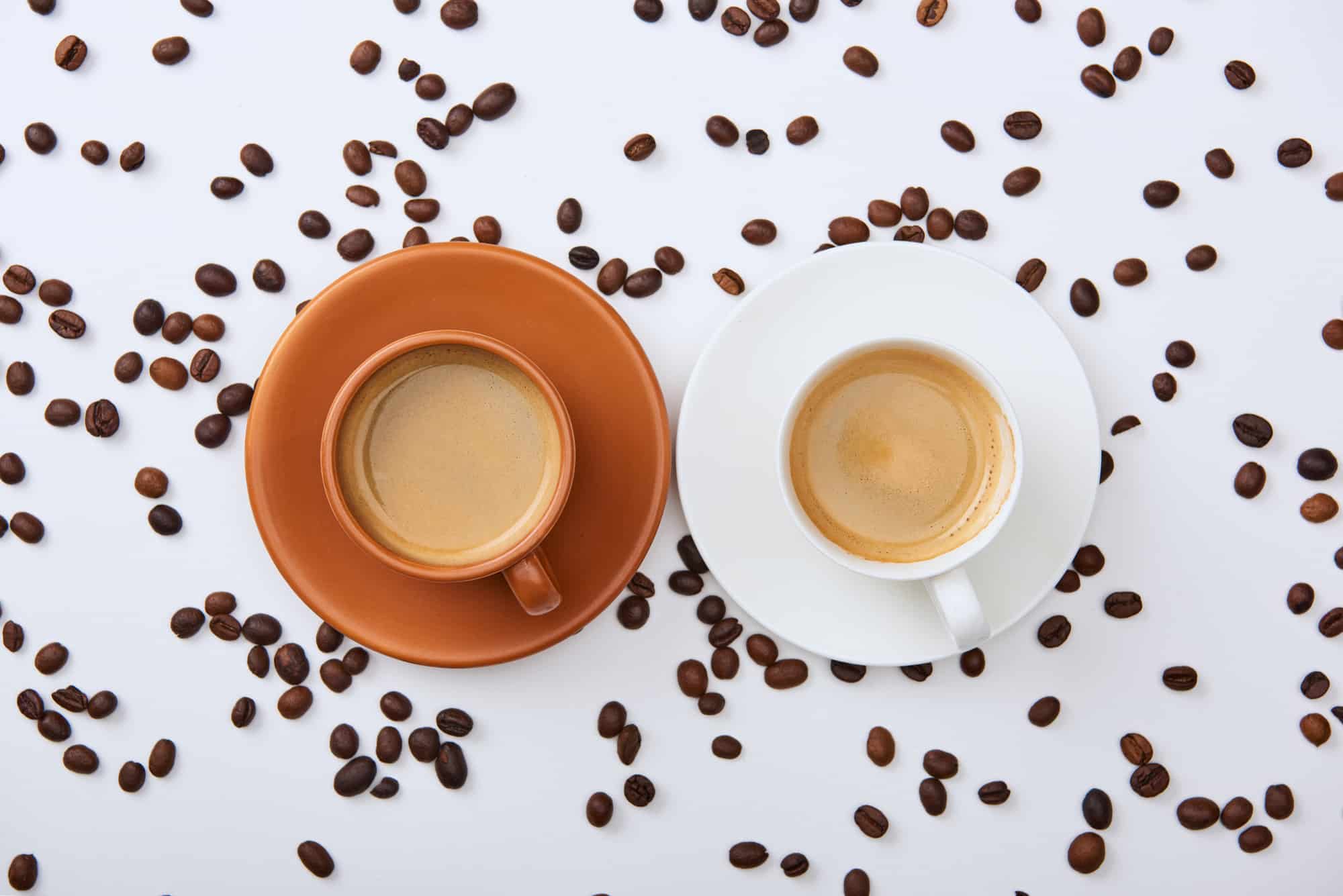
Safest Coffee? Pesticides Used in Coffee Production All Over The World
You don’t have the safest coffee if your brew is full of pesticides. It’s important to understand that sometimes when it comes to things we are importing into the United States, we could be introducing toxic chemicals not legal in our own food supply. Then again, some of those chemicals could be the same ones we use but with higher allowable levels. There are several toxic pesticides used in coffee production. The aroma may be pleasant, but here’s a list of some of the most common pesticides, fungicides, and herbicides you’ll miss out on if you purchase organic coffee products instead.
Here are some of the trace amounts of pesticides you may find in your coffee, so to have the safest coffee, you’ll want to avoid the pesticides on this list.
- Methyl Parathion: Used to fight leaf miner infestations, this toxic chemical is highly toxic to humans, mammals, birds, and fish. It’s an extremely hazardous insecticide that has been banned in India since 2016, banned in Indonesia, & banned in the European Union.
- Endosulfan: Used to fight against the coffee cherry borer, this dangerous pesticide doesn’t dissolve easily in the soil and is toxic to most animals. It affects the central nervous system, liver, kidneys, reproductive organs, and even death.
- Chlorpyrifos: This pesticide class has been banned in the United States for household use because of birth defects.
- Triadimefon: This copper-based fungicide is used against coffee rust. It’s suspected reproductive problems can arise with chronic exposure. Studies have also linked it to hyperactivity in rats. In Kenya and Costa Rica, this copper-based fungicide has accumulated in the soils and become a problem.
- Paraquat dichloride: This “moderately hazard” herbicide has been banned in the European Union. However, it’s still legal in India, US, Brazil, & Colombia.
- Abamectin: This moderately hazardous insecticide is legal everywhere.
- Aldicarb: This extremely hazardous insecticide has been banned everywhere but Brazil. So you’ll find this chemical on some Brazillian coffee beans that are not organic.
- Carbofuran: This is a highly hazardous pesticide that is banned in the European Union and Canada. This chemical is an endocrine disruptor and very dangerous at trace amounts. In 2009, the EPA restricted this chemical for human consumption, which is a de facto ban.
- Cirpoconazole / cyproconazole: This is a slightly hazardous fungicide that is restricted for household use in the US. Cyproconazole is a reproductive toxicant in EPA’s 2011 predictive model of reproductive toxicity. Cyproconazole demonstrated it can induce liver swelling in mice according to studies.
- Cypermethrin / ZetaCypermethrin: This moderately hazardous insecticide is banned in India. Cypermethrin is used to control parasites that infest cattle and ticks on docs.
- Dichlorvos / DDVP: This moderately hazardous organophosphate insecticide is banned in several countries. A study found a link to increased odds of ADHD in children. Banned in the European Union, the United Kingdom, Denmark, Sweden and restricted in US.
- Disulfoton: This extremely hazardous organophosphate insecticide is made by Bayer/Monsanto, the same company that brought you glyphosate, DDT, PCBs, and Agent Orange. It’s banned in the European Union and India.
- Haloxyfop: This moderately hazardous herbicide is restricted in the European Union.
- Imidacloprid: This moderately hazardous insecticide may see a ban from Canada soon. The primary effects of longer-term, low dose exposure to imidacloprid are on the liver, thyroid, and body weight.
- Permethrin: This moderately hazardous insecticide is banned in the European Union and restricted in the United States. It’s used to treat scabies and lice and can be applied to the skin as a lotion. As an insecticide, it’s sprayed on clothing and crops.
- Phorate: This extremely hazardous insecticide is banned in the European Union and India. Phorate is very easily absorbed and its toxicity is high.
- Propiconazole: This moderately hazardous fungicide is banned in the European Union.
- Terbufos: This extremely hazardous organophosphate insecticide is banned in the European Union and restricted in the United States. Organophosphate poisoning is not common in the United States, but cases of terbufos poisoning occur in the developing world. This insecticide is widespread and very dangerous for farmers.
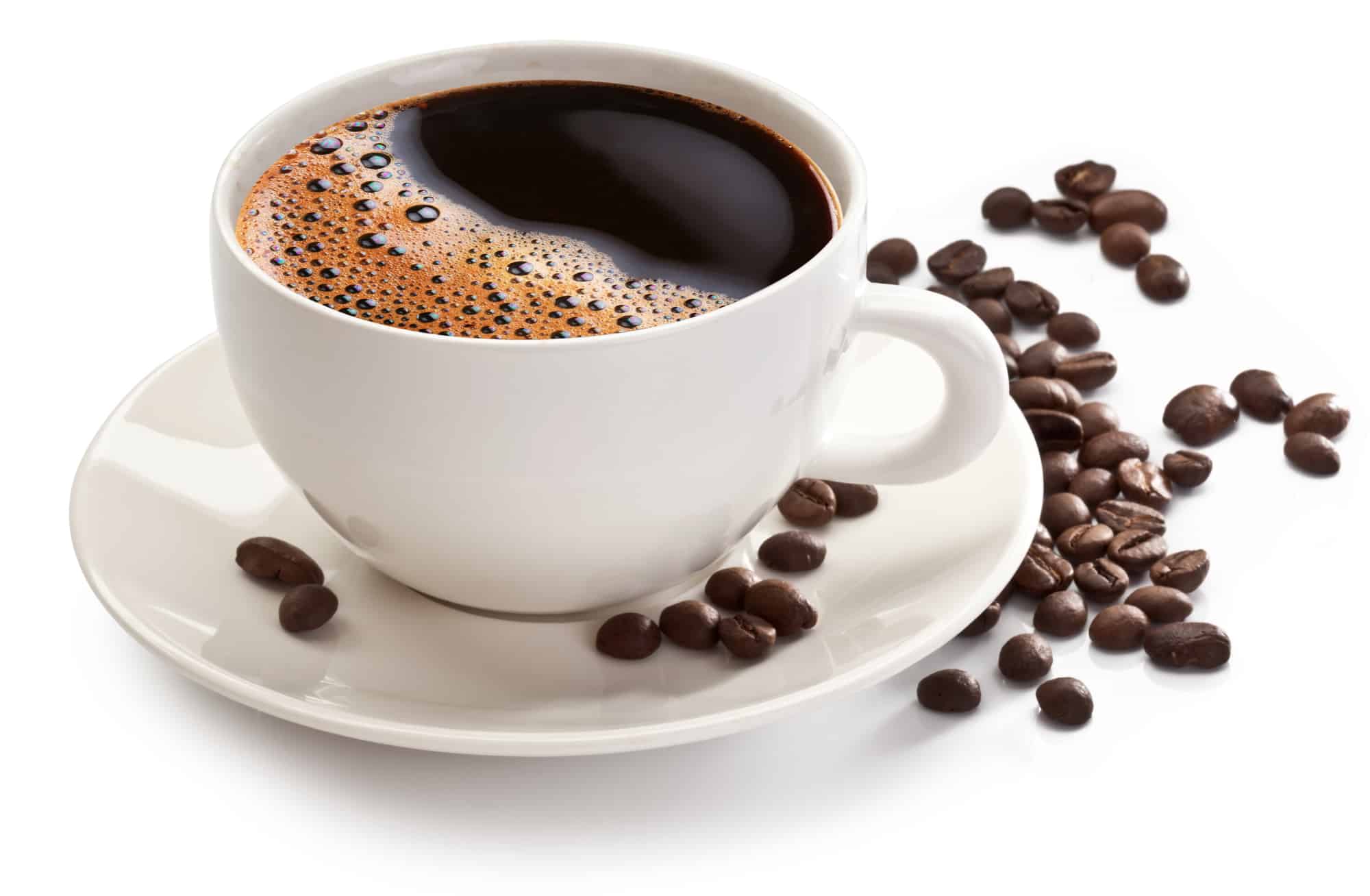
Mycotoxins In Coffee May Cause Problems Or May Not Depending On Your Genes So Pay Attention For Safest Coffee
Mycotoxins are naturally occurring toxins produced by certain molds and fungi according to the World Health Organization (WHO). You are exposed to them in your environment and food. When it comes to food, they grow in coffee beans, grains and cereals, dried fruits, nuts, spices, cocoa beans, and apples. Molds produce mycotoxins when they grow and spread and these mycotoxins in high amounts are dangerous to both animals and humans.
Years ago in Europe, a study found about 18 mycotoxins in roasted coffee, mostly aflatoxins in low concentrations. 34% of the samples also contained mycotoxin Ochratoxin A. It’s very likely coffee sold in the United States would be similar or perhaps worse. You’ll also find mycotoxins in some animal products, including eggs and dairy products (if the animals ate contaminated feed). Here’s the mycotoxins mostly found in coffee:
- Aflatoxin B1: this Mycotoxin is a known carcinogen and studies have shown that in large doses it can have harmful effects. Aspergillus mold produces Aflatoxin. Aspergillus molds grow mostly on crops, such as grains and nuts. Aflatoxin is the most common mycotoxin on earth.
- Ochratoxin A: is a Mycotoxin that’s commonly found in coffee as well as cereals, bread, fruits, spices, and even beer. This type of Mycotoxin can also be transmitted to eggs and meat via contaminated feed. Penicillium and Aspergillus produce Ochratoxin.
Methods of Processing & Roasting Coffee Beans Changes The Quality For The Safest Coffee
Coffee beans are not really beans. They are the seeds of berries, known as a “cherry.” These seeds are locked inside a berry and removing them can be challenging. Different processes can change the flavor, acidity, and amount of mycotoxins are inside.
- Wet Method: Coffee is pulped and then rinsed in water removing layers of fructose and sucrose. This method allows the acidity to be prominent.
- Other natural processes: Leave the coffee seeds intact while drying, which makes coffee sweeter and increases the number of mycotoxins.
Coffee beans go through various stages of processing before they get to you. When the beans are green in the very beginning stages of processing, mold can form as the coffee beans are stored and transported. Even the world’s strongest coffee can contain these issues.
Higher Elevations Breed Less Mycotoxins in Coffee Beans–Find The Safest Coffee
The higher the elevation the beans come from, the less mold will have the ability to grow. Cooler mountain temperatures provide a slower growth cycle for the coffee tree which prolongs bean development. This longer maturation process imbues the coffee bean with more complex sugars, yielding deeper and more compelling flavors, and also protects it from mycotoxins.
So we looked into areas that were popular destinations for coffee and helped you get an idea of the differences. They come from far away, so sadly sustainability goes out the window from the distance. Ethiopia, Columbia, Kenya, Guatemala, Sulawesi, & Papua New Guinea come out as the highest and thus safer from mycotoxins.
- Very High Altitude –1500 meters. Flavors: fruity, spice, floral, berry, & wine. (Ethiopia, Columbia, Kenya, Guatemala, Sulawesi, Papua New Guinea)
- High Altitude–1200 meters. Flavors: citrus, vanilla, chocolate, & nut. (Costa Rica, Java Sumatra, Nicaragua, Honduras, Mexico Altura)
- Medium Altitude–900 meters. Flavors: smooth & sweet. (Brazil Bourbon Santos)
- Low Altitude–760 meters. Flavors: subtle, soft, mild, simple. (Hawaiian Kona, Vietnam, Indonesia, & Jamaica)
- Very Low Altitude–600 meters

To Put This In Perspective: Mycotoxins Are In Other Crops In Larger Amounts. It’s Ubiquitous.
I know we covered a lot about mycotoxins, but to the average person, this isn’t going to matter. Coffee is actually on the lighter end of food that is contaminated with mycotoxins. Grains and peanuts are far more problematic.
The American Food and Agriculture Organization (AFAO) estimates that 25% of the food crops in the world are affected by mycotoxins, primarily aflatoxins. The crops that are most affected are corn, cottonseed, and peanuts. But you are also getting a dose in coffee beans, beans, rice, tree nuts, and wheat.
One of the other problems with mycotoxins is they get into other parts of the food supply through animal consumption. If the dairy cow consumes hay or other crops with mycotoxins, then they will pass through to the milk & meat. The same goes for eggs & chicken.

Acrylamide in Coffee is Linked to Cancer, However, You Can Control The Amount
Just when you were overwhelmed by toxins from fungus, you also have to learn about another carcinogen inside the coffee, acrylamide. Acrylamide is linked to cancer and coffee is one of your major exposures to it, followed by baked goods and fried potatoes. Make these selections to cut down on acrylamide in your coffee.
- Pick dark roast vs. light roast
- Choose arabica beans vs. robusta beans
- Select brewed coffee vs. espresso or french press coffee (I cried when I heard this.)
- Brew it freshly from beans vs. instant
Acrylamide in coffee varies from 5 parts per billion (ppb) per cup to 605 parts per billion (ppb) per cup. Don’t worry, this is all reflected in our investigation. We’ve included the rest of the results from the FDA in our brand investigation to reflect the brands that were lower in higher rankings. Sadly, your hazelnut instant coffee brands need to get pitched.

Where Acrylamide is Also Found in Your Kitchen–Baked Goods & Fried Potatoes
But acrylamide isn’t only found in coffee. There are many other parts of your food, especially if you eat processed foods, where you will have acrylamide present. Here is a cross-section of brands studied by the USDA. Here are some examples pulled out for you. Long story short, it may not really be your coffee that is killing you. Think about your processed foods like baked good, potatoes, and other processed snacks.
- 36 ppb for un-toasted Pepperidge Farm white bread
- 216 for toasted Pepperidge Farm white bread
- 266 for Cheerios
- 497 for McDonald’s French fries (the highest tested out of 7 locations)
- 768 for Burger King hash browns
- 1,265 for Kettle potato chips, lightly salted variety
- 1,540 for Health Valley oat bran graham crackers
- 1,970 for Trader Joe’s veggie chips potato snacks
- 2,510 for Pringles BBQ flavor
- 4,080 for Blue Mesa Grill sweet potato chips
The Federal Drug Administration produces a manual on acrylamide and how to avoid it. Long story short, if you treat your baked goods like grandma did and take the time to let things ferment and break down, it lowers the amount of acrylamide. Imagine that. Here’s a couple of recommendations on how to bring down acrylamide in baked goods:
- Allow baked goods the time to yeast ferment and break down
- Use lower temperatures for longer periods of time
- Lower baking temperatures during final stages where moisture levels are low
- Avoid convection ovens because they increase the amount of acrylamide in baked goods
- Darker artificial colors increase the amount of acrylamide present
- The lower the sugar content the lower the amount of acrylamide
- Adding amino acids like cysteine or glycine lowers the amount of acrylamide
- Avoid products using calcium propionate as an ingredient

Organic Coffee Production Solves Most of the Problems Consumers Have with Coffee
What does it mean when you purchase organic coffee beans? Well, most of what we went over is mitigated. Organic farmers can’t use most of the chemical-based inputs conventional farmers can use. And their practices minimize the presence of other toxins. Here’s what you can look forward to when purchasing:
- No synthetic fertilizers. Farmers use the coffee pulp, chicken manure, and general compost from coffee growing to fertilize the fields.
- No toxic, synthetic pesticides can be used on the farm. This is better for the farmworkers and the consumers. (Don’t be fooled into thinking that there are no pesticides in organic. They have a small amount at their disposal and this how they create a plan to use them.)
- Coffee is grown in the shade, not the sun like on conventional coffee farms. This encourages natural wildlife to flourish and provides shade for the workers. But this also means less can be produced on a square foot. That’s reflected in the price.
- Studies link organic food with higher antioxidant content. In general, organic has demonstrated higher antioxidant content. Coffee is by far a major source of antioxidants for the day so that would be great for your health as well.
- Organic Food Production Act of 1990 (OFPA) keeps an eye on the coffee after it’s been harvested by regulating the chemicals used in processing.

Heart Burn Sufferers–How to Control Acidity in Your Coffee
Controlling the bitterness and acidity in our cup of coffee is helpful for those who suffer from heartburn, acid reflux, or indigestion. Some evidence points to caffeinated beverages like coffee making those symptoms worse, so if that is the case for you, perhaps a cup of low acid brew is something to try. There are several brands that specialize in low acid coffee beans. But you can also control that based on how you grind the beans and how hot the temperature is.
- More acidic: Course grind, high water temperature
- More biter (low acid): Fine grind, medium to high temperature
A course coffee grind results in more acidity. A finer coffee grind results in more bitterness. A longer brew time allows for more time in the extraction and a bitter coffee. A shorter brew time allows for less time in the extraction and more acid in their coffee.
For people who are are looking for low acid coffees, there isn’t an exact science to removing that. Each brand seems to have a process. But it’s worth pointing out that in this instance that lower elevation coffee beans have lower acidity. So for lower acidity, look for coffee beans from Hawaii, Brazil, Indonesia, & Mexico.

Decaffeinated Coffee–What’s The Point? It’s Bad For You.
Millions of people around the world drink decaffeinated coffee and it shouldn’t happen. Other than the fact that it has less caffeine, it has no other benefit. In fact, it could be hurting you. This list is all the decaf coffee brands without detectable methylene chloride.
Processing with Solvents: The processing of removing the caffeine requires the involvement of a mixture of solvents typically including methylene chloride, ethyl acetate, (DCM, or Dichloromethane) or CO2. This mixture soaks into the coffee beans and slowly the caffeine is released. The process is repeated repeatedly until there are only trace amounts of caffeine remaining. There are laws in place to protect the consumer from how much solvent residue is acceptable in the coffee. (Don’t worry, the process is safe in organic.)
No More Mycotoxins & Acrylamide Protection: Caffeine had a protective presence in the coffee from mycotoxins and acrylamide. When you remove the caffeine from coffee, you lose that protection.
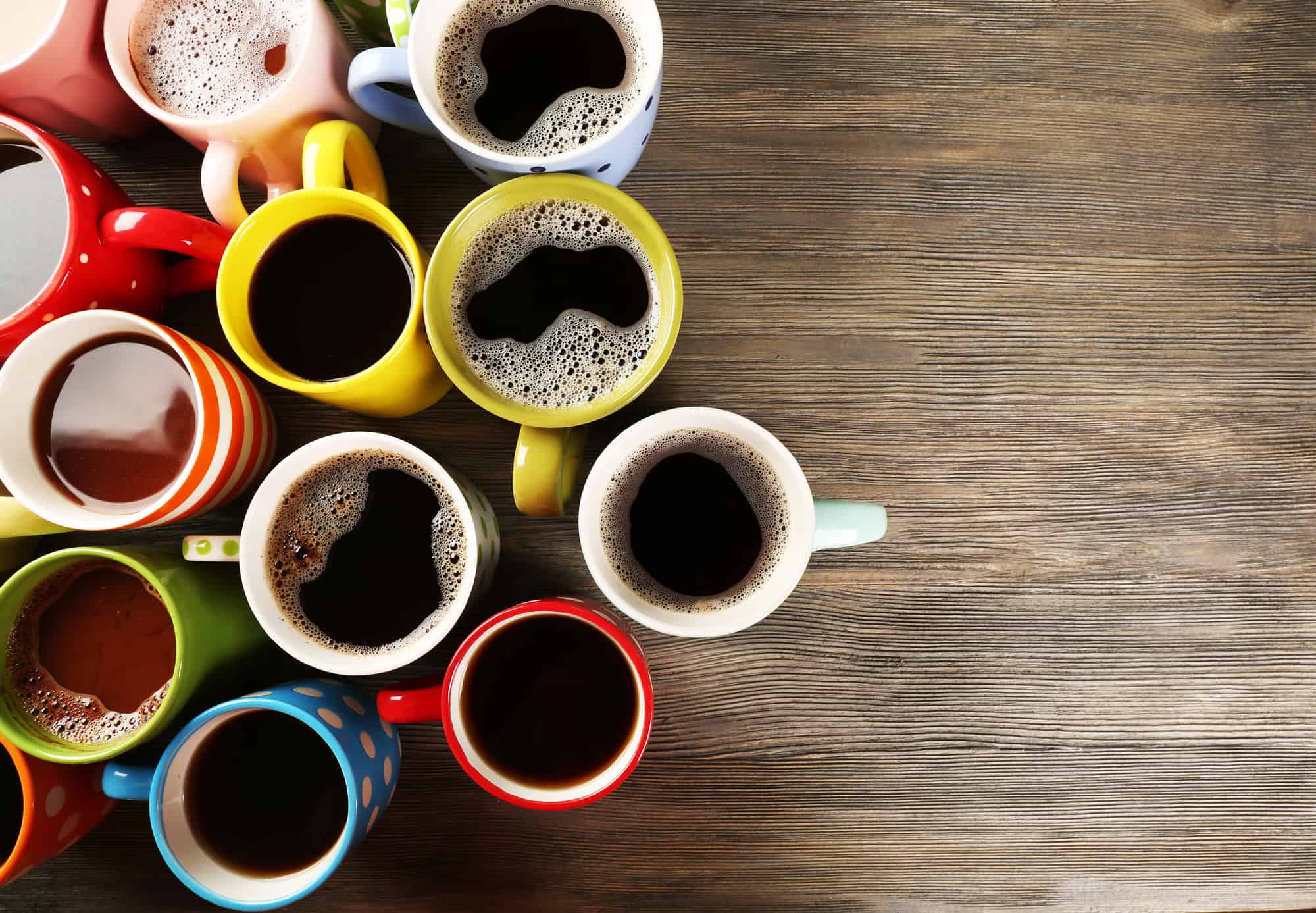
Different Certifications of Coffee
When you are purchasing coffee, there are many different certifications available to you, but these are the ones that are the most relevant to your needs.
USDA Organic

Coffee sold in the United States as organic must follow the standards established by the USDA’s National Organic Program. Private accredited certifying organizations verify farmers as organic. The requirements for this certification require the farm to farm organically for at least three years before they qualify. They are prohibited from using toxic, synthetic pesticides, synthetic fertilizers, and other chemical inputs. These methods capture carbon, prevent soil erosion, protect farmworkers and consumers from dangerous pesticides.
Bird-Friendly (Smithsonian Migratory Bird Center)

Developed by ecologists at the Smithsonian Migratory Bird Center, this is the only true “shade-grown” certification. It starts off as organic certification. This bird-friendly certification is the most robust shade/habitat standard of any coffee certification. Canopies of trees need to be at least 12 meters high with the dominant tree species being native to the area. A minimum of 40% shade cover even after pruning of at least two strata or layers of vegetation needs to stay. And there needs to be at lease 10 woody species dispersed throughout the production area
Rainforest Alliance (Merged with Utz)
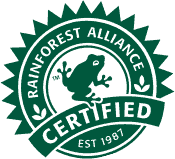
The Rainforest Alliance certifies crops like coffee with their sustainable agriculture program. It covers a number of ecological issues as well as community relations and fair treatment of workers. Certification is awarded based on a score for meeting a minimum number of an array of criteria within the standard. Unlike the Smithsonian certification, there are no criteria for shade management. The criterion is for “native vegetation cover” and is not required for six years, and sometimes longer. Therefore it is important to note that Rainforest Alliance-certified coffee may not be shade-grown. There is no organic requirement.
Fairtrade America & Fairtrade USA
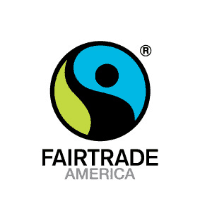
This gets confusing. The main fair trade organization which sets standards is Fairtrade International (FLO), and the Fairtrade label is exclusively licensed by Fairtrade America in the U.S. Products bearing this label meet the international standard, which is only available to democratically-organized cooperatives or associations of small producers. This certification does not certify individually owned farms or estates in order to ensure standards are being met consistently.
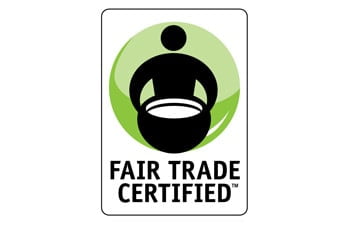
Fair Trade USA is another certifier of fair trade coffee. They were once part of Fairtrade America, but are now independent. Under this system, independent producers and estates can gain certification.
Black Plastic Additives Can Leach Into Coffee? Houston: We Have a Problem.
Do you have a black plastic coffeemaker? Most people do. Most coffeemakers are a perfect opportunity for plasticizer chemicals to leach. But most recently, the color plastic could be the most important piece of that puzzle. What he found was the presence of brominated flame retardants, chlorine, PVC, cadmium, chromium, mercury, lead, and antimony coming out of black plastic.
The black plastic study was led by Andrew Turner of Plymouth University in the United Kingdom. He used XRF spectrometry to assess the levels of a range of elements in more than 600 pieces of black plastic products that come into contact with food & beverages. Black plastic is thought to be particularly problematic because most of it is recycled from end-of-life electronic equipment like computers and stereo equipment. Therefore, black plastic doesn’t belong around food.
Coffee roasters beware! We would also caution you around brands selling pods for the Keurig drip coffee system. Even though the plastic around the pods is not black, it’s still plastic and has unknown additives within the plastic that can leach into your brew.

Mamavation Recommendations on Coffeemakers
Mamavation highly recommends you get a coffeemaker that doesn’t have any plastic touching the hot liquid of your coffee. Here are some of our favorite options & brands:
- Classic Chemex 10 Cups of Coffee Pour Over
- Classic Chemex 6 Cups of Coffee Pour Over
- Nee Porcelain Coffee Dripper
- Bodum Slow Vacuum Coffeemaker Slow Brew
- AGOGO Glass Coffee Maker Pour-Over
- Ovalware Cold Brew Coffee Maker
- Bodom Pedom Coffee Maker with Vacuum, strong flavor
- Gvode Stainless Steel Mesh Pour-Over Coffee Maker
- West Bend Electric Coffee Perculator
- Ilsa Stainless Steel Espresso Coffee Maker
- Hario Woodneck Drip Pot Coffee Maker
- SAKI Pour-Over Coffee Maker
- COLETTI Coffee Percolator
- FORLIFE Cafe Style Glass Coffee/Tea Press
- Nee Porcelain Coffee Dripper
- Stainless Steel French Press Coffee Maker
- Faberware 12 Cup Stainless Steel Percolator
- AMFOCUS Stovetop Espresso Maker
This ranges from the classic Cemex pour-over to the single pour-over cup method. Coffee tastes so much better when it’s never touching plastic. More options are available here. Try it!

Top 8 Tips For a Healthier Cup of Coffee
1. Avoid Drinking Decaffeinated Coffee
This is simply pointless unless you just really really like the taste. As I mentioned above the caffeine in coffee helps to prevent Mycotoxins and acrylamide from harming you. Simply put, the caffeine acts as a Mycotoxin inhibitor and protector.
2. You Want Your Coffee Processed Using the Wet Method
Always try and drink coffee that’s been processed via the wet method. This may be hard to decipher when you are at the supermarket, but if you are at a cafe, they will know. Mycotoxins are typically formed during the drying stage of coffee processing. Wet beans are much less likely to contain these molds and fungi over dry beans. This is the process by which they shed the layers and get to the coffee bean.
3. Growing Environment –Elevation, Elevation, Elevation!
The environment where the coffee beans are growing plays a role in the number of Mycotoxins in the coffee beans. Mold spores are far less likely to grow at higher elevations so buying coffee beans that have been grown and harvested in the mountains is a simple way to decrease the risk of Mycotoxins in your coffee. Select coffee beans from the countries of Ethiopia, Columbia, Kenya, Guatemala, Sulawesi, & Papua New Guinea.
4. Type of Coffee Beans: Always Arabica!
The type of coffee beans can also be a factor in coffee Mycotoxins. Robusta beans are more likely to contain mycotoxins, so make sure to select arabica beans. Even though Robusta varieties do contain more caffeine than Arabica, they are also prone to containing more Mycotoxins.
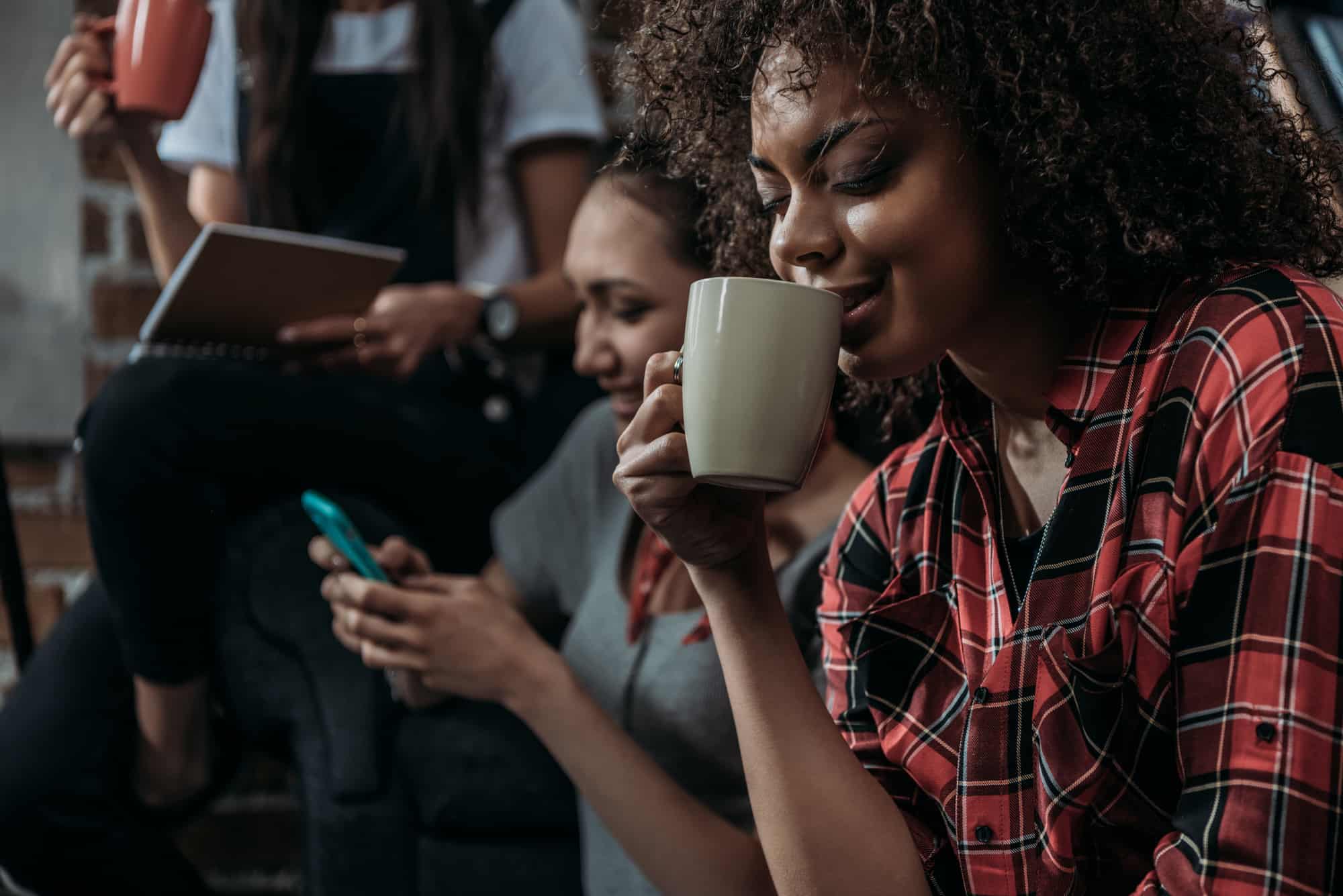
5. Coffee Blends–Just Say No!
Even though coffee blends may taste good, there isn’t an easy way to tell where the beans have originated from. Sometimes these blends are created from throwaway beans that no one wanted anyway.
6. Go Organic! ☮️
Organic coffee producers don’t use the toxic synthetic pesticides we pointed out above, nor do they use synthetic fertilizers. In fact, organic coffee orchards use shady treetops to grow coffee where wild animals are still encouraged to flourish. Because of the elevation and longer harvest, they are also typically lower in mycotoxin.
7. Select Dark Roast Brew Ground From the Bean Please!
When it comes to the type of brew you select, you can avoid acrylamide by selecting (1) dark roast over light roast, (2) ground from the bean over instant, & (3) brewed coffee over espresso or french press. So you want a dark roast brew ground from the bean. Dark roasts include French Roast, High Roast, New Orleans Roast, Espresso Roast, Viennese Roast, Italian Roast, Continental Roast, & European Roast.
8. Just Say No to Plastic Additives!
When you brew that cup of coffee, don’t do it in a coffee machine that is made of plastic. Toss that coffee maker and pick up one of our favorites here on Mamavation! If you are getting a cup a coffee while out, ask for a ceramic cup. Better yet, bring your own!

Mamavation Investigation of Coffee Brands
Mamavation investigated over ? coffee brands looking for various attributes to determine quality. We considered region and altitude of the coffee, processing methods, testing done by the FDA over the years, type of bean, and whether it’s a blend.
Not Our Favorite Coffee Brands
These brands are the lowest quality. There are a number of things we looked at to determine this. Here are some of those possibilities: The FDA report determined they had more than 200 parts per billion (ppb) acrylamide per cup, they are made from Robusto beans, they are grown in regions known for higher acrylamide & mycotoxins, or they are made from instant coffee, which typically contains higher levels of acrylamide. Brand names with numbers are the amount of acrylamide per cup the FDA determined. Organic light roast coffees made it to this list because light roasts are linked with higher acrylamide. Brands that didn’t have very much information available to the public went here as well.
- French Market Restaurant Blend Coffee and Chicory 609ppb
- Nescafe Classic Instant Coffee 471 ppb
- Community Coffee & Chicory New Orleans Blend 459 ppb
- Folgers Classic Roast Instant Coffee 458 ppb
- Taster’s Choice Gourmet Roast Instant Coffee 411 ppb
- Luzianne Coffee & Chicory (ground, not brewed) 381 ppb
- Safeway Instant Coffee 377 ppb
- Folgers Classic Roast 350 ppb
- Melitta Traditional Premium Roast 332 ppb
- Taster’s Choice Vanilla Roast Instant Coffee 286 ppb
- Cafe Regil Rige Y Regira 100% Coffee 203 ppb
- Tim Horton’s Classic Coffee Beans

The Better Brands of Coffee
These brands of coffee are much better than the bad ones. But they still have some issues. We considered the following things: (1) The FDA tested and found between 200 ppb and 45 ppb in their coffee, they are not organic so could have trace amounts of solvents or pesticides, they are not organic so may have higher levels of mycotoxins & acrylamide per cup. Brand names with numbers are the amount of acrylamide per cup the FDA determined. Not all brands listed were evaluated by the FDA, so some will not have info on acrylamide, but based on trends we can easily figure out where they belong.
- Yuban 100% Columbian 45 ppb
- Hills Bros 100% Colombian 64 pbb
- Seattle’s Best Medium Roast 91 ppb
- McGarvey Twin Cities Blend 93 ppb
- New England Coffee Co. French Roast 94 ppb
- Hawaiian Isles Kona Sunrise 97 ppb
- Starbucks French Roast 97 ppb
- Aspen Select Texas Pecan Whole Bean Coffee 99 ppb
- Harmony Bay Breakfast Blend 102 ppb
- Cafe Bustelo Dark Roast 134 ppb
- Medaglia D’Oro Caffe’ Espresso Coffee 144 ppb
- Seaport 100% Pure Dark Roast 148 ppb
- Hills Bros Coffee 149 ppb
- Starbucks House Blend 151 ppb
- Chock full o’ Nuts Rich French Roast 154 ppb
- Starbucks Breakfast Blend 161 ppb
- Starbucks Columbia Ground 163 ppb
- Folgers French Roast 163 ppb
- Cafe Oquendo 100% Pure Coffee 168 ppb
- Maxwell House Original Signature 170 ppb
- Caribou Coffee Rainforest Blend 180 ppb
- Maxwell House French Roast 184 ppb
- Super G Instant Coffee 188 ppb
- Chock full o’Nuts All-Method Grind 197 ppb
- Tim Hortons Dark Roast Coffee

The Best Brands with Safest Coffee
These brands come from the highest altitude and are 100% organic and are offering the safest coffee. This means no toxic, synthetic pesticides were used, synthetic fertilizers, or harsh solvents to process. These beans were also grown in shaded forests where wildlife populations were able to flourish and the farmworkers had shade to work. The finer you grind your coffee, the lower the acid.
- Aldi’s Barissimo Fair Trade Organic Whole Bean Coffee (Peru)
- Aldi’s Simply Nature Organic (Honduras)
- Biggby Organic Costa Rica
- Black Oak Meadow Organic Coffee
- Blue Bottle Three Africas Blend
- Charleston Coffee Organic Columbian
- Deathwish Organic Coffee
- Ethical Bean Coffee Superdark
- Equal Exchange Organic French Roast
- Highwire Conscientious Objector
- Isagenix Organic Coffee
- Jose’s Organic Mayan Blend
- Kicking Horse Organic Three Sisters
- Kicking Horse Organic Kick-Ass Coffee Beans
- Kion Coffee
- Lifeboost Organic Single Origin Medium Roast Coffee
- Nabob Organic Reserve
- Nature’s Promise Organic Breakfast Blend Ground Coffee
- Newman’s Own Organic Breakfast Blend
- Pete’s Organic French Roast
- Ruta Maya Organic Dark Roast Coffee
- Saltspring French Roast
- Scout & Cellar Scouting Grounds (Mamavation independently tested this coffee for 400+ pesticides, mold, & yeast and all was non-detect at the lowest standardized detection limits.)
- Sprouts Organic French Roast Coffee
- Trader Joe’s Organic Cold Brew Coffee Nitrogen-Infused
- William Spartivento Organic Columbian Pipnita
Pin it!






 Could Widespread Glyphosate Contamination Be Fueling New Pea Allergy?
Could Widespread Glyphosate Contamination Be Fueling New Pea Allergy?
Mamavation is absolutely 💯 great. Include the full bodied balanced Mayorga Cuban (organic) Style Cafe whole bean coffee, I brought a very expensive machine but no coffee equals it’s rich full bodied but not bitter brew.
Subtle Earth coffee was rated as one of the best decaf options in this post:
https://www.mamavation.com/food/decaffeinated-coffee-methyl-chloride.html
It was not mentioned in this post. Does anyone have an idea where it would rank?
Thanks!
Thank you for this great article
Under the BEST coffee list- for “Pete’s Organic French Roast” did you mean “PEET’s Organic French Roast”? I cannot find a “Pete’s Organic French Roast”, but I have found a “Peet’s”.
Thank you for all you have done with this site and informing us. I never buy anything now until I have visited your site.
WHAT DO YOU THINK OF ORINOCO MOCHA JAVA BLEND? IT IS ORGANIC
LYNN
Do you ever test Target’s organic brands?
Are any of those listed from guatemala?
I am surprised that there is no mention of coffee under the Costco name. I bet more of that is sold than any other coffee named here, bad, good or ugly.
I’m so glad to talk about this content. It’s incredible!
Such positive thoughts are moving in the mind of every person all the time and it is something that is new for us.I feel very gratefulthat I read this. It is very helpful and very informative and I really learned a lot from it.
I did not see Gevalia mentioned. How does it stack up?
I did not see Gevalia brand mentioned. How is it rated?
Which of the “best” are grown in high altitude, wet processed, etc to address mycotoxin levels?
Don’t see lifeboost coffe.
Can you rate Black Rifle Coffee please??? Have given this brand as gifts!!! Thank you.
Leah – I really appreciate all of the hard work you do and enjoy reading your articles. They are very helpful! But as a Colombian woman, it is a huge pet peeve when someone spells Colombia with a u! There is no country of Columbia! If at all possible, could you please update your amazing post with the correct spelling for Colombia? Thank you!!
I prefer Folgers 1850 trailblazer. You mentioned a couple of Folgers being good. I’m hoping Folgers 1850 is good?
I also use Folgers 1850 coffee! I wish I could find some real info about it. If you call their customer service line the rep just reads a scripted response regarding the mold, pesticides that basically says they follow are government recommendations.
The great boost of info for coffee lovers! Thanks for giving us the scoop of what goes on behind the cup!
Great info. Thanks!
I didn’t see bulletproof coffee on your list. Any thoughts?
I’m disappointed to see you recommend Blue Bottle Coffee. They are now owned by NESTLE, one of the biggest corporate water polluters and plastic users in business.
Eight O’Clock coffee is a common brand in groceries. What about Columbian Peaks Whole Bean coffee ? The flavor after it is ground is soft winey and wonderful.
No mention of Swiss Water Method for safely decaffeinating organic coffee beans though? Not all decaf is dangerous, and this should be updated to reflect this fact.
https://naturalforce.com/blogs/nutrition/what-is-swiss-water-decaf
We drink organic coffee fairtrade and equal exchange from the coops. Also, does William Spartivento qualify as a higher end product?
Are any of Starbucks coffees organic?
We cold filter our coffee. Is that a good way to go or do you preferred brewed?
This was super helpful! I’ve been searching for this kind of information on Nespresso. Is any update available for this brand?
Wow. I always knew decaffeinated was bad for a body, but this has been a wealth of information to me. Thank you so much.
(:
The best info on this topic I’ve ever seen. I wonder if you can explain the data behind how caffeine protects against acrylamides? Thanks!
I was pleased to see Jose’s organic Mayan blend was on here. Been buying this one for some time now….but I thought this article said coffee bean BLENDS are bad since cannot know where they come from?
Anyone know of this coffee is mold tested? Or where it stands on mytoxins? And PAH’s?
What about boiled coffee? I am Armenian, we cook it slightly. It has the most coffee oil compared to French press or espresso. And could you please explain why French press or espresso are worse than drip? When it drips, all oil stays in the coffee filter, so in drip coffee it’s caffeinated water. Just the benefit of caffeine, but not the oil which is full of antioxidants. Can’t be good.
Thank you so much for all this info!!!
I make my own Cold Brew in a large mason jar, that comes with a stainless steel filter, special to make cold brew
i use LIFE EXTENSION Rainforest Blend both caffeinated and decaf.
I make both types, and drink the decaf cold brew in the afternoons, so I can sleep at night.
I drink a lot of both, and would love your comments. I’ve always wondered if this a good idea, but never found someone as knowledgeable as you, to ask.
Please let me know what you think.
Thanks again
Carol, I am a huge cold brew fan as well & also make mine with a mason jar but I use Bizzy Coffee’s dark roast – highly recommend, its the best cold brew I’ve had. (/www.bizzycoffee.com)
Can you expand on why French presses aren’t suggested? I was just curious as mine is made of glass with only minimal components of plastic that don’t touch the hot coffee until time to press it and then pour quickly after.
I also want to know the same thing. My french press has only glass and no plastic at all.
Plastic is not the issue with French press because there is none. the issue is brewing time to avoid the acrylamide, carcinogen. Brewing, which takes longer reduces acrylamide, as opposed to French press and espresso machines that are quicker.
dark over light roast, and bean over instant, also help avoid acrylamide.
100,000 THANK YOUS! Have shared to my page. This is incredibly helpful!
xxSada
Ugh! I went into this article with my heart in my throat! I absolutely LOVE coffee!
But it’s a great investigation!! It’s always important to know what we’re putting into our bodies
Can you explain why brewed coffee vs. Espresso? I just bought an espresso machine. Is the argument that there’s are more acreylamides in espresso? How much more?
Leah – have you researched safe coffee grinders?
Thank you!
I believe that the hazard is due to the heat involved,.. since you dont heat the beans when grinding, I am not concerned with it as much. We all need to be more concerned with putting hot food in plastic and heating things in the microwave,
Yes, please! I’d like to know too!
What about Nespresso?
I have their highest model Creatista Plus. It was a gift and I enjoy it but I want to know if it’s safe.
Wow, what a great boost of info for coffee lovers! Thanks for giving us the scoop of what goes on behind the cup!
Hello! Thank you for this! What about the Amazon organic brand? Thanks!!
Hi Leah,
EXCEPTIONAL investigation, yet again! LOVE LOVE LOVE this article! Several years ago, I discovered Dave Asprey and his process of Bulletproof coffee and slowly started to get into it, even though my fave was Japanese Matcha. Now I buy direct from FreshRoastedCoffee.com, either Organic African or Guatemalan – High Altitude, of course. I knew alot but your investigation added more to my knowledge. Keep up the INCREDIBLE amazing work Leah!
This is ONE of my All Time Faves!
What about Keurig products?
We did not study K cups or other single serving coffees during this investigation. I’d love to see that tho!
K cups would be toxic due to plastic
What about Whole Foods brand??
Thanks for all you do!!
What About Bulletproof and other Purity as well as blue bottle coffees? Thank you
Purity is on the list. 6th from the bottom.
would love to know about Bulletproof and Portola as well 😀
How about Bulletproof ? They claim there are no mycotoxins (mold) in it
Where does Dunkin Donuts fall? I don’t drink this but my dad does every day. Would love to hear more! Thanks for doing this. I’ll probably still do my French Press, it has no black plastic!
Dunkin is a “bad coffee” but it’s my favorite.
Any tests done on Copper Cow Coffee? It’s all I drink🤣